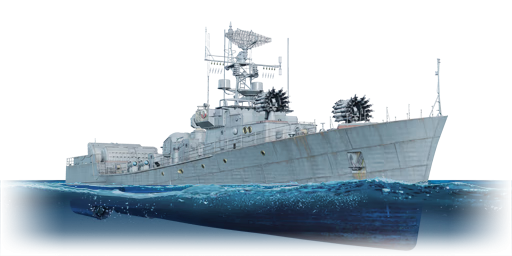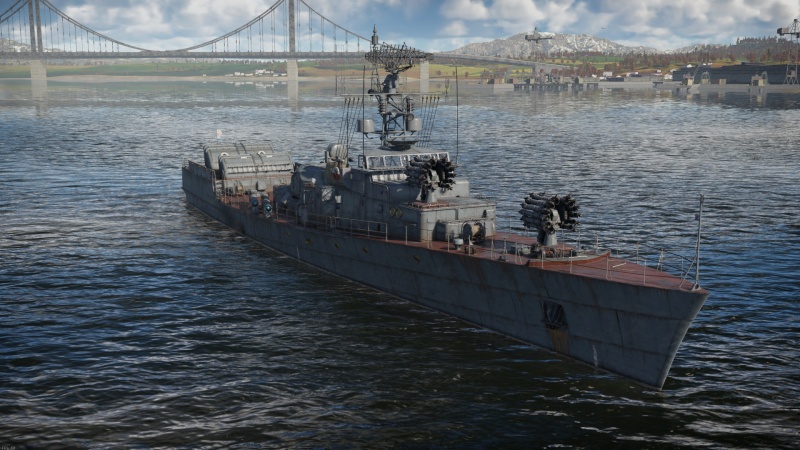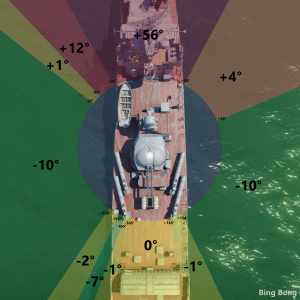MPK Pr.204
Contents
Description
The MPK Pr.204 (NATO reporting name: Poti-class) was a Soviet Cold War corvette class, built for anti-submarine warfare during the 1960s. The Poti-class ships were the first to be powered by gas turbine, and unlike the preceding Project 122bis-class were also significantly smaller. The draught of the Poti-class was to be made as shallow as possible and was only 2 m. The ships were also the fastest corvettes built by the Soviet Union with a maximum speed of 70 km/h. The armament of the Pr.204 consisted of a single 57 mm AK-725 twin automatic artillery system astern, two RBU-6000 anti-submarine rocket launchers and four tubes with SET-40 homing torpedoes. A total of 66 ships were made, with six sold to Bulgaria and three to Romania. None of the vessels survived to this day, the class was replaced in Soviet service by Project 1241.2 Molniya.
The Project 204 was introduced in Update "Sky Guardians". It is the fastest subchaser in the Soviet coastal tree. The main disadvantage of the ship comes from the only offensive armament being located astern, forcing the captain of the vessel to show the full broadside of the ship when trying to engage enemy surface vessel. The torpedoes on the Pr.204 are also very weak as their main usage was against submarines and not surface vessels. The torpedoes carry only 80 kg TNT eq. with maximum speed of 54 km/h and fairly decent range of 8 km.
General info
Survivability and armour
Talk about the vehicle's armour. Note the most well-defended and most vulnerable zones, e.g. the ammo magazine. Evaluate the composition of components and assemblies responsible for movement and manoeuvrability. Evaluate the survivability of the primary and secondary armaments separately. Don't forget to mention the size of the crew, which plays an important role in fleet mechanics. Save tips on preserving survivability for the "Usage in battles" section. If necessary, use a graphical template to show the most well-protected or most vulnerable points in the armour.
Mobility
Write about the ship's mobility. Evaluate its power and manoeuvrability, rudder rerouting speed, stopping speed at full tilt, with its maximum forward and reverse speed.
| Mobility Characteristics | |||
|---|---|---|---|
| Game Mode | Upgrade Status | Maximum Speed (km/h) | |
| Forward | Reverse | ||
| AB | |||
| Upgraded | 98 | 42 | |
| RB/SB | |||
| Upgraded | 65 | 27 | |
Modifications and economy
Armament
Primary armament
Provide information about the characteristics of the primary armament. Evaluate their efficacy in battle based on their reload speed, ballistics and the capacity of their shells. Add a link to the main article about the weapon: {{main|Weapon name (calibre)}}. Broadly describe the ammunition available for the primary armament, and provide recommendations on how to use it and which ammunition to choose.
| Penetration statistics | |||||||
|---|---|---|---|---|---|---|---|
| Ammunition | Type of warhead |
Penetration @ 0° Angle of Attack (mm) | |||||
| 100 m | 1,000 m | 2,000 m | 3,000 m | 4,000 m | 5,000 m | ||
| OR-281U | HEF-I* | 5 | 5 | 5 | 5 | 5 | 5 |
| BR-281U | APCBC | 147 | 114 | 87 | 66 | 50 | 38 |
| Shell details | ||||||||||||
|---|---|---|---|---|---|---|---|---|---|---|---|---|
| Ammunition | Type of warhead |
Velocity (m/s) |
Projectile mass (kg) |
Fuse delay (m) |
Fuse sensitivity (mm) |
Explosive mass (TNT equivalent) (g) |
Ricochet | |||||
| 0% | 50% | 100% | ||||||||||
| OR-281U | HEF-I* | 1,000 | 2.8 | 0 | 0.1 | 235.62 | 79° | 80° | 81° | |||
| BR-281U | APCBC | 1,000 | 2.8 | 1.2 | 20 | 20.02 | 48° | 63° | 71° | |||
Additional armament
Describe the available additional armaments of the ship: depth charges, mines, torpedoes. Talk about their positions, available ammunition and launch features such as dead zones of torpedoes. If there is no additional armament, remove this section.
Usage in battles
Describe the technique of using this ship, the characteristics of her use in a team and tips on strategy. Abstain from writing an entire guide – don't try to provide a single point of view, but give the reader food for thought. Talk about the most dangerous opponents for this vehicle and provide recommendations on fighting them. If necessary, note the specifics of playing with this vehicle in various modes (AB, RB, SB).
Pros and cons
Pros:
- Powerful primary armament with high fire rate, good turret traverse speed, and high elevation angle
- Strong AP shells with decent penetration, muzzle velocity, and explosive mass
- Has access to RBU-6000 mortars and four torpedoes
- Has both search and tracking radars
Cons:
- Poor firing angles for the primary armament, especially to the starboard side
- Mediocre anti-aircraft abilities due to lack of auxiliary/anti-aircraft guns and no HE-VT shells
- Slow torpedoes with very low explosive mass in fixed torpedo tubes that are unable to traverse
- Relatively poor survivability, despite displacing over 500 tons
- Exposed ammo racks for both primary armament and rockets
History
Describe the history of the creation and combat usage of the ship in more detail than in the introduction. If the historical reference turns out to be too long, take it to a separate article, taking a link to the article about the ship and adding a block "/History" (example: https://wiki.warthunder.com/(Ship-name)/History) and add a link to it here using the main template. Be sure to reference text and sources by using <ref></ref>, as well as adding them at the end of the article with <references />. This section may also include the ship's dev blog entry (if applicable) and the in-game encyclopedia description (under === In-game description ===, also if applicable).
Media
- Skins
- Videos
See also
Links to articles on the War Thunder Wiki that you think will be useful for the reader, for example:
- reference to the series of the ship;
- links to approximate analogues of other nations and research trees.
External links
Paste links to sources and external resources, such as:
- topic on the official game forum;
- other literature.
| USSR sub-chasers | |
|---|---|
| Pr. 122 | MPK pr.122A · MPK Pr.122bis |
| Pr. 163 | MPK-163 |
| Pr. 201 | MPK Pr.201K · MPK Pr.201M |
| Pr. 204 | MPK Pr.204 |






